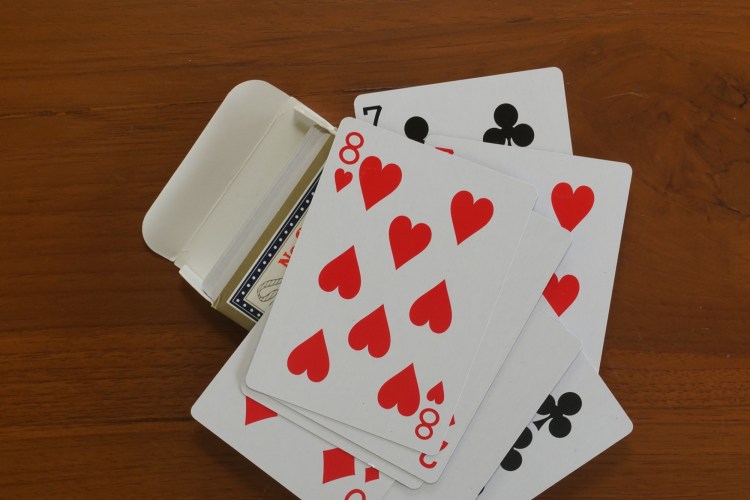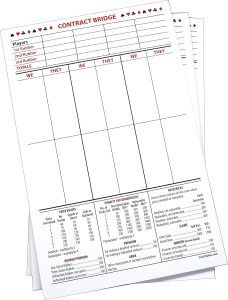Rubber Bridge is a variant of the contract bridge that is often used during a friendly game of kitchen bridge. The scoring is simple, and indeed forms the foundation of all bridge scoring.
What is Rubber Bridge?

What is Rubber Bridge?
by Jude Goodwin
Rubber Bridge is a variant of the card game bridge that is most often used during a friendly game of kitchen bridge. The scoring is simple, and indeed forms the foundation of all bridge scoring.
This form of bridge gained a lot of publicity after a celebrated match, referred to as the “Bridge Battle of the Century“, was held December 1931 to January 1932 between teams led by Ely Culbertson and Sidney Lenz. A total of 150 rubbers were played, and the match was ultimately won by the Culbertson team by a margin of 8,980 points. The purpose of the ‘battle’ was to pit Culbertson’s new bidding system agains the Official System, and it’s a great story!
The mechanics of Rubber Bridge are the same as Duplicate Bridge and Chicago Bridge. There’s a deal, a round of bidding, an opening lead, and then play of the hand. If you know the basics of bridge, you can sit down and play Rubber Bridge with no problem. In fact, many bridge teachers might recommend starting with Rubber Bridge. The difference is the scoring and learning how to manipulate the scoring and outcomes to your advantage. Let’s take a look.
Rubber Bridge Scoring
 Rubber bridge scoring combines both below-the-line and above-the-line points, a system that rewards both contract fulfillment and overtricks while penalizing underperformance.
Rubber bridge scoring combines both below-the-line and above-the-line points, a system that rewards both contract fulfillment and overtricks while penalizing underperformance.
In the image at left, you can see a very common rubber bridge score pad. You see We and They and a line for below and above the line points. Most score pads will have the value of tricks and other point awards also on the pad for easy reference.
When you score 100 points or more below the line, you have a ‘game.’ Two games and you win a bonus, and the rubber is over. Time for round two! The only way you can score points below the line is to bid and make a contract. Overtricks are scored, but above the line. And of course, if you don’t make your contract, the opponents score but below the line. Here’s a basic outline:
Below-the-Line Points (Toward Game)
- Contract Points: Awarded for winning tricks that meet the contract bid. These points count toward winning a game.
- Minor suits (Clubs and Diamonds) score 20 points per trick over six.
- Major suits (Hearts and Spades) score 30 points per trick over six.
- No Trump (NT) scores 40 points for the first trick over six and 30 points for each subsequent trick.
Above-the-Line Points (Bonus and Penalty)
- Overtricks: Points awarded for tricks won beyond the contract. These do not count toward game but increase the overall score.
- Undoubled overtricks score the same as the contract trick points.
- Doubled overtricks score 100 points each if non-vulnerable, 200 if vulnerable.
- Redoubled overtricks double the points of doubled overtricks.
- Slam Bonuses: Awarded for bidding and making a slam.
- Small Slam (winning 12 tricks) awards 500 points if non-vulnerable, 750 if vulnerable.
- Grand Slam (winning all 13 tricks) awards 1000 points if non-vulnerable, 1500 if vulnerable.
- Undertricks (Penalties): Points awarded to the opposing team for the contract’s failure to make the bid number of tricks.
- The penalty points vary depending on whether the contract was doubled, redoubled, and the vulnerability status.
- Rubber Bonus: Awarded to the side that wins two out of three games.
- 700 points for winning a two-game rubber.
- 500 points if the rubber is decided in three games.
Additional Points
- Honors: Points awarded for holding high cards in the trump suit or all four aces in a No Trump contract. Note, this is more common in casual play and not always applied in competitive settings.
- Doubled or Redoubled Contract Bonus: Additional points are awarded for making a contract that was doubled or redoubled.
Winning the Rubber
- A “game” is won when a partnership scores 100 or more below-the-line points in a single deal. Points below the line from different deals do not cumulate towards game wins.
- A “rubber” is won by the partnership that wins two games. The rubber ends at that point, and the final score is tallied, including rubber bonuses, overtricks, undertricks, and any other bonuses.
Let’s talk about Vulnerable
A key consideration when playing Rubber Bridge is whether or not you, or the opponents, are Vulnerable. The term “vulnerable” refers to a pair (or a team) that has already won a game within the current rubber. A rubber is a match that consists of the best of three games. Being “vulnerable” affects scoring and strategy, as penalties for failing to make a contract are higher when vulnerable, and bonuses for making certain contracts are also increased. A pair becomes vulnerable after winning a game within the rubber and remains so until the end of the rubber.
Here is how vulnerability works in Rubber Bridge:
- At the start of the rubber, both pairs are not vulnerable.
- Once a pair wins their first game, they become vulnerable for the remaining part of the rubber, increasing the risk and reward for both teams.
- If a pair has not yet won a game within the current rubber, they are considered “not vulnerable.”
- It’s possible to have both pairs vulnerable, if each has one game.
- After a pair wins two games, the rubber ends, and scores are totaled to determine the overall winner.
Rubber Strategy
Rubber Bridge strategy is a big topic – and there are some excellent books! My favourite is Bridge for Blood published in 1966 by Ray Young and republished in 1973. Reading it today still gives me a giggle. Here’s a fun story.
Many years ago when my friend Julie and I were first starting out as bridge players, we were challenged by our mentors (read: Bridge Gods) to a game of Rubber Bridge. “For money,” one of them said, with a smile. Julie and I had never played rubber bridge – only duplicate – so we were intrigued but intimidated at the same time. We knew we were lambs being led to the slaughter. Then I found Bridge for Blood – a book on how to win at Rubber Bridge. I studied it furiously and shared everything with Julie and when the the time came to play we won the day – and the money! Our mentors were very grumpy, claiming, “You’re not playing real bridge.” Indeed, the approach to bidding and play in Rubber is different that that of Duplicate. Even the approach to play and defense is different. But I honestly believe if you learn Rubber Bridge before all other variants, you’ll end up being a more informed player.
Because I’m writing an introductory article here, I won’t go into the nuances of strategy, but you can find a lot of great information on Karen Walker’s Rubber Bridge Strategy page here. And in Ray’s book.
But don’t let strategy put you off. You can sit down with a rubber bridge score pad and 4 people and have a really enjoyable time even if it’s your very first game. Beyond the rules and strategies, Rubber Bridge is a social game. It’s often played in homes and clubs, where the competition is friendly. The game’s structure makes it accessible to players of different skill levels, allowing everyone to participate and enjoy.
Bridge for money
Do bridge players play for money? Did you win any money? This is a common question from my friends and family. And the answer is ‘no.’ I play duplicate bridge in clubs and tournaments and I don’t win money – I win masterpoints. And personal pride in my accomplishments of course. But is there such a thing as money bridge? The answer is yes, and it’s called Rubber Bridge. Typically it involves playing “a penny a point” or some variation of that.
What do you mean I have a leg up?
Bridge has many different terms, and there are some great glossaries out there, including this one on the American Bridge Association website. But here are a few I remember from my childhood during the 1950s while listening to my mother talk bridge with her neighbours.
I had a leg up: “A leg up” means being vulnerable vs. non-vulnerable opponents. “Cut off their leg” means becoming vulnerable vs. opponents who are already vulnerable.
We started with a Fast Rubber: A rubber completed in two games is called a Fast Rubber. A Slow Rubber is completed in three games.
Table Up! Cut in and cut out: In rubber bridge, it is customary on completion of a rubber to invite other players in the room to play in the next one, often by a cry of “Table up”. The players in the completed rubber draw cards to determine who will withdraw; the one or more who draw the lowest card or cards are said to cut out, and their replacements to cut in.
Goulash: This is a style of dealing, usually at home games, where the cards are not thoroughly shuffled between deals and are dealt in groups. It results in “wild” card distributions. I think I remember playing this style of deal at a few Midnight Swiss games as well – back in the ‘old days.’
I recommend that you definitely call your bridge friends together and play a whole lot of Rubber Bridge as part of your learning journey. See you at the table!








